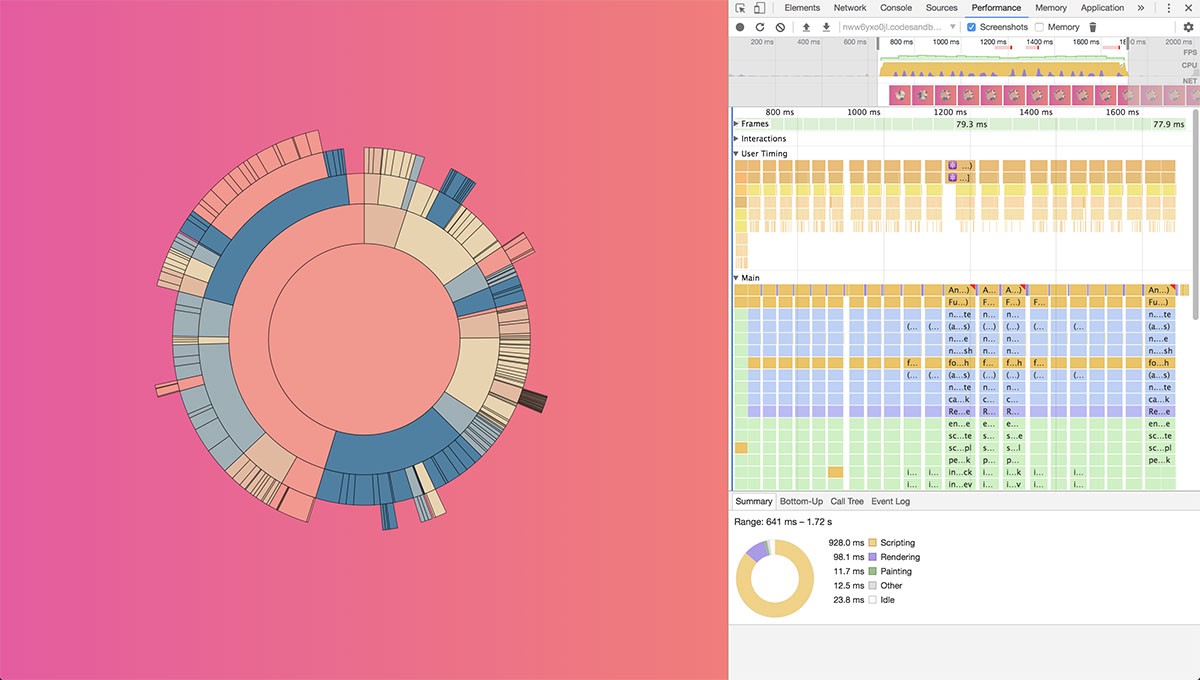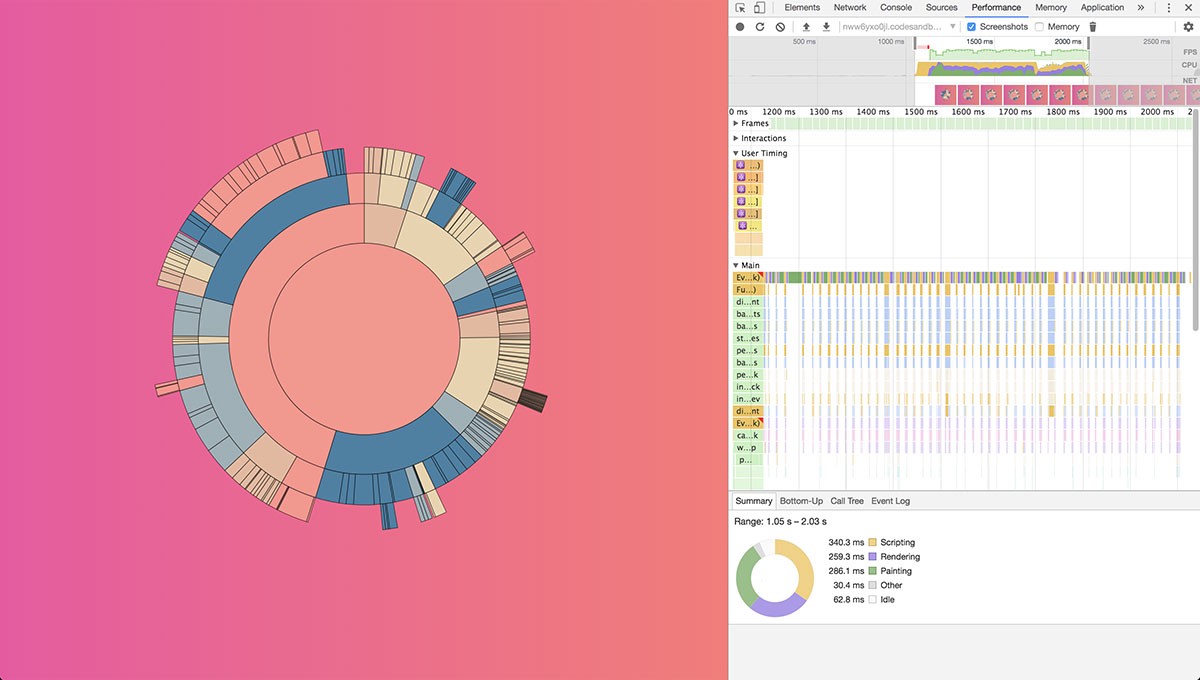- Springs and basic interpolation
- Render props
- Native rendering and interpolation
- Imperative Api
- Transitions
- Parallax and page transitions
For a raw documentation of all possible properties look here.
You can interpolate almost everything, from numbers, colors, svg-paths, percentages, arrays to string patterns:
<Spring to={{
scale: toggle ? 1 : 2,
start: toggle ? '#abc' : 'rgb(10,20,30)',
end: toggle ? 'seagreen' : 'rgba(0,0,0,0.5)',
stop: toggle ? '0%' : '50%',
rotate: toggle ? '0deg' : '45deg',
path: toggle ? 'M20,380 L380,380 L380,380 Z' : 'M20,20 L20,380 L380,380 Z',
vector: toggle ? [1,2,50,100] : [20,30,1,-100],
}}>The from prop denotes initial values and to end-state values the spring will animate towards. Once the spring starts animating from plays no role any longer, it will from now on remember its current values and animate from there if you update to.
A couple of extra props you might be interested in are onRest, which fires once the animations stops, onFrame, which fires on every frame and gives you the animation value, reset, which literally resets the spring so that it goes through from to to again, immediate which can enforce values to spring to their to-values immediately (can be true for a zero-time spring or a function which receives the key names and returns true or false individually).
react-spring is one of the few libs that understands and animates auto, so you can use it in your configs, like so:
<Spring from={{ height: 0 }} to={{ height: 'auto' }}>But keep in mind that in order to do this we have to measure out a snapshot set to height/width: auto before we can start animating it. If you notice that the measured bounds are wrong, give your view more context, for instance set the position attribute of the parent container (the element that contains your spring) to either absolute or relative so that the view (the element that's inside your spring) retains bounds.
Don't like the way render props wrap your code and create nested structures? By default we support both render and children, so you can create higher-order components like so:
const Header = ({ children, bold, ...styles }) => (
<h1 style={styles}>
{bold ? <b>{children}</b> : children}
</h1>
)
<Spring render={Header} to={{ color: 'fuchsia' }} bold>
hello there
</Spring>Et voilà! Header animates on prop changes! Props that Spring doesn't recognize will be spread over the receiving component, in this example bold, but it also includes children if you use render to refer to the render-child.
Native rendering and interpolation (Demo)
By default we'll render every frame (like in the image on the left) as it gives you more freedom (for instance this is the only way that you can animate React-component props). In situations where that becomes expensive use the native flag. The flag is available for all primitives (Spring, Transition & Trail, Keyframes, Parallax is native by design). Try doing this in all situations where you can, the benefits are worth it. Especially if your animated component consists of large subtrees, routes, etc.
Just be aware of the following conditions:
nativeonly animates styles and attributes- The values you receive are opaque objects, not regular values
- Receiving elements must be
animated.[elementName], for instancedivbecomesanimated.div - If you need to interpolate styles use
interpolate
import { Spring, animated, interpolate } from 'react-spring'
<Spring native from={{ radius: 0, time: 0, x: 0, y: 0 }} to={{ radius: 10, time: 1, x: 10, y: 20 }}>
{({ radius, time, x, y }) => (
<animated.div
style={{
// Use plain animated values like always, ...
borderRadius: radius,
// For interpolations, call "interpolate" on the value itself, it accepts a function
background: time.interpolate(t => `rgba(0, 0, 0, ${t})`),
// ... or supply a range clamp
color: time.interpolate({ range: [0, 1], output: ['red', 'rgba(1, 50, 210, 0.5)'] }),
// Or use generic interpolate, which takes multiple values, it accepts a function
transform: interpolate([x, y], (x, y) => `translate(${x}px, ${y}px)`),
}}>
</animated.div>
)}
</Spring>In cases where you need to clamp or extrapolate, the interpolate function can take several properties that might be of interest to you. Specifically range, output, filter, extrapolate, extrapolateLeft and extrapolateRight. You can also chain results and interpolate further.
<animated.div
style={{
transform: x
.interpolate({
// Map can route the input value through a custom filter
// In this case we convert absolute values; helpful for delta-offsets for instance
map: Math.abs,
// Range and Output map input values to output values
range: [50, 300],
output: [0.5, 1],
// Can be "extend" (default) or "clamp", clamp cut's off
extrapolate: 'clamp',
})
.interpolate(x => `scale(${x})`), // interpolates the result of the above
}}
/>If it's necessary you can control your animations imperatively.
import {
AnimatedValue,
animated,
interpolate,
controller as spring,
} from 'react-spring'
const App = ({ children }) => {
const animation = new AnimatedValue('#28d79f')
const hover = () => spring(animation, { to: '#c23369' }).start()
const unhover = () => spring(animation, { to: '#28d79f' }).start()
return (
<animated.div
style={{ background: animation }}
onMouseOver={hover}
onMouseOut={unhover}
/>
)
}Animates children as they mount and unmount. from denotes base styles, enter styles are applied when objects appear, leave styles are applied when objects disappear. Keys and children have to match in their order! The keys are the same that you would provide in any other looping situation.
import { Transition } from 'react-spring'
<ul>
<Transition
keys={items.map(item => item.key)}
from={{ opacity: 0, height: 0 }}
enter={{ opacity: 1, height: 20 }}
leave={{ opacity: 0, height: 0 }}>
{items.map(item => styles => <li style={styles}>{item.text}</li>)}
</Transition>
</ul>For more complex animations you can return per-object styles individually. Let Transition know the actual data by passing it raw to items, either pass your keys like always or give it an accessor. And for more control, there's update which fires for nodes that are neither entering nor leaving.
<Transition
items={items}
keys={item => item.key}
from={item => ({ opacity: 0 })}
enter={item => ({ opacity: 1 })}
update={item => ({ opacity: 0.5 })}
leave={item => ({ opacity: 0 })}>
{items.map(item => styles => <li style={styles}>{item.text}</li>)}
</Transition>You can use this prototype for two-state reveals, simply render a single child that you can switch out for another. You don't have to pass keys for this one.
<Transition from={{ opacity: 0 }} enter={{ opacity: 1 }} leave={{ opacity: 0 }}>
{toggle ? ComponentA : ComponentB}
</Transition>If you need to track a single child, that is also possible:
<Transition from={{ opacity: 0 }} enter={{ opacity: 1 }} leave={{ opacity: 0 }}>
{toggle && Component}
</Transition>Trail animates the first child of the list you pass, the others will follow in a trailing motion. The api is similar to Transition though it will assume your list is fixed.
import { Trail } from 'react-spring'
<Trail from={{ opacity: 0 }} to={{ opacity: 1 }} keys={items.map(item => item.key)}>
{items.map(item => styles => <div style={styles}>{item.text}</div>)}
</Trail>Parallax creates a scroll container. Throw in any amount of layers and it will take care of moving them in accordance to their offsets and speeds.
Parallax.pages determines the total space of the inner content where each page takes 100% of the visible container. ParallaxLayer.offset determines where the layer will be at when scrolled to (0=start, 1=1st page, ...). ParallaxLayer.speed shifts the layer in accordance to its offset, values can be positive or negative.
import { Parallax, ParallaxLayer } from 'react-spring'
<Parallax pages={3} scrolling={false} horizontal ref={ref => this.parallax = ref}>
<ParallaxLayer offset={0} speed={0.5}>
<span onClick={() => this.parallax.scrollTo(1)}>
Layers can contain anything
</span>
</ParallaxLayer>
</Parallax>
